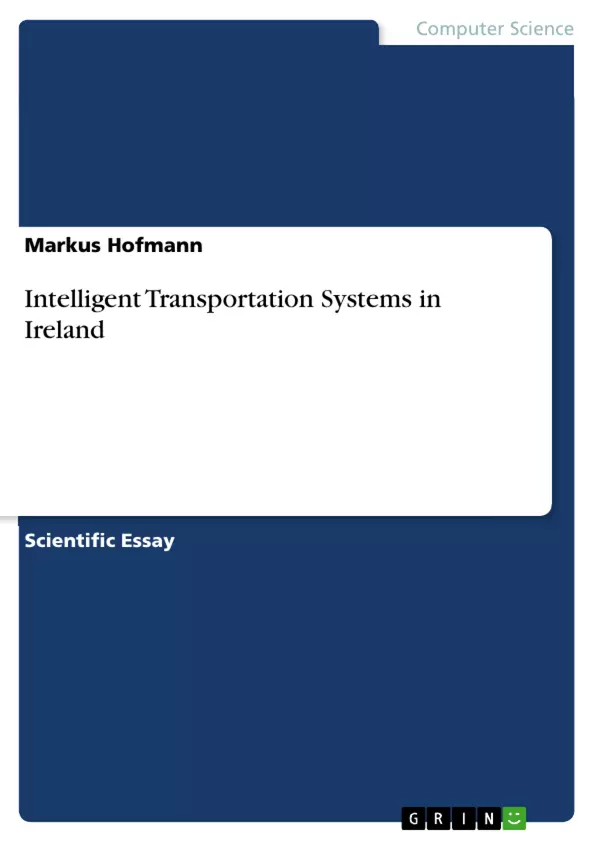Traffic is very dynamic and unpredictive and therefore it is quite difficult to manage and control traffic flow. Intelligent Transportation Systems (ITS) can support traffic management by implementation of state of the art technologies. Dublin′s traffic situation is worsening daily due to the fact that the rate of car ownership and population increase dramatically. This paper gives the reader an overview of ITS and the various categories. It is aimed for people working in the transportation industry, government departments, transportation committees, and of course for the general public who has interest in transportation management. The result of this paper is that Dublin could improve the current situation by implementing ITS systems.
Inhaltsverzeichnis (Table of Contents)
- 1. INTRODUCTION.
- 2. INTELLIGENT TRANSPORTATION SYSTEMS AND ITS CATEGORIES
- 2.1 ADVANCED TRAVELLER INFORMATION SYSTEM (ATIS)
- 2.1.1 Description.....
- 2.1.2 Technologies used..
- 2.1.3 Implemented successfully.
- 2.1.4 Suitability for Dublin
- 2.2 ADVANCED TRAFFIC MANAGEMENT SYSTEMS (ATMS)
- 2.2.1 Description.
- 2.2.2 Technologies used..
- 2.2.3 Implemented successfully..
- 2.2.4 Suitability for Dublin..
- 2.3 ADVANCED IN-VEHICLE TECHNOLOGIES.
- 2.3.1 Description.
- 2.3.2 Technologies used..
- 2.3.3 Implemented successfully..
- 2.3.4 Suitability for Dublin.
- 2.4 FREIGHT & FLEET MANAGEMENT SYSTEMS
- 2.4.1 Description.
- 2.4.2 Technologies used..
- 2.4.3 Suitability for Dublin Institute of Technology.
- 2.5 ADVANCED PUBLIC TRANSPORT SYSTEMS
- 2.5.1 Description....
- 2.5.2 Technologies used....
- 2.5.3 Implemented successfully.
- 2.5.4 Suitability for Dublin Institute of Technology.
- 2.6 EMERGENCY MANAGEMENT SYSTEMS
- 2.6.1 Description...
- 2.6.2 Suitability for Dublin Institute of Technology.
- 2.7 ELECTRONIC PAYMENT SYSTEMS.
- 2.7.1 Description.....
- 2.7.2 Technologies used..
- 2.7.3 Implemented successfully.....
- 2.7.4 Suitability for Dublin.
- 2.8 ADVANCED SAFETY SYSTEMS
- 2.8.1 Description.
- 2.8.2 Technologies used..
- 2.1 ADVANCED TRAVELLER INFORMATION SYSTEM (ATIS)
- 3. TREND ANALYSIS OF INTELLIGENT INFORMATION SYSTEMS .....
- 3.1 GOVERNMENT.
- 3.2 DEMOGRAPHY.
- 3.3 SOCIETY
- 3.4 ENVIRONMENT.
- 3.5 ECONOMICS.
- 3.6 TECHNOLOGY.
- 4. DUBLIN'S TRANSPORTATION SYSTEM – PRESENT AND FUTURE.
- 4.1 BUS
- 4.2 RAIL...
- 4.3 ROADS
- 5. PRESENT AND FUTURE TRAFFIC ESTIMATION
- 5.1 GENERAL ESTIMATION AND FACTS
- 5.2 PEAK HOUR TRIPS IN GREATER DUBLIN AREA (GDA)...
- 5.3 INTERNATIONAL BENCHMARKING OF THE BUS SEGMENT AS PUBLIC TRANSPORT...
- 5.4 GEOGRAPHICAL AND ECONOMIC FEATURES.
- 6 PROBLEMS ASSOCIATED WITH ITS
- 7. CONCLUSION.
Zielsetzung und Themenschwerpunkte (Objectives and Key Themes)
This paper provides an overview of Intelligent Transportation Systems (ITS) and their various categories, aiming to highlight their potential to improve Dublin's traffic situation. The paper is geared towards individuals within the transportation industry, government departments, transportation committees, and the general public interested in transportation management.
- The impact of ITS on traffic management and its potential applications in Dublin.
- Different categories of ITS, including Advanced Traveler Information Systems (ATIS), Advanced Traffic Management Systems (ATMS), and Advanced In-Vehicle Technologies.
- Analysis of Dublin's transportation system and its challenges.
- Trends and factors influencing the development and implementation of ITS.
- The potential benefits and challenges associated with ITS implementation.
Zusammenfassung der Kapitel (Chapter Summaries)
- Chapter 1 provides an introduction to the topic of Intelligent Transportation Systems (ITS) and their relevance to Dublin's traffic management.
- Chapter 2 delves into various categories of ITS, including Advanced Traveler Information Systems (ATIS), Advanced Traffic Management Systems (ATMS), Advanced In-Vehicle Technologies, Freight & Fleet Management Systems, Advanced Public Transport Systems, Emergency Management Systems, Electronic Payment Systems, and Advanced Safety Systems. Each category explores its description, technologies used, successful implementation examples, and suitability for Dublin.
- Chapter 3 examines key trends influencing ITS, focusing on factors related to government policies, demographics, societal needs, environmental considerations, economic development, and technological advancements.
- Chapter 4 provides an overview of Dublin's current transportation system, encompassing bus, rail, and road infrastructure, highlighting the challenges and opportunities for ITS implementation.
- Chapter 5 delves into traffic estimation, presenting general statistics, peak hour trips within the Greater Dublin Area (GDA), international benchmarking of public transport (specifically the bus segment), and geographical and economic features influencing traffic patterns.
Schlüsselwörter (Keywords)
This paper explores the concept of intelligent transportation systems, focusing on their application in Dublin, Ireland. Key terms include: intelligent, transportation, industry, Dublin, Ireland, information, traffic management, technology, and public transport.
- Citar trabajo
- Markus Hofmann (Autor), 2001, Intelligent Transportation Systems in Ireland, Múnich, GRIN Verlag, https://www.grin.com/document/1769



